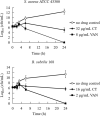New Insights Into the Antibacterial Mechanism of Cryptotanshinone, a Representative Diterpenoid Quinone From Salvia miltiorrhiza Bunge
- PMID: 33717044
- PMCID: PMC7950322
- DOI: 10.3389/fmicb.2021.647289
New Insights Into the Antibacterial Mechanism of Cryptotanshinone, a Representative Diterpenoid Quinone From Salvia miltiorrhiza Bunge
Abstract
The rapid rise of antibiotic resistance causes an urgent need for new antimicrobial agents with unique and different mechanisms of action. The respiratory chain is one such target involved in the redox balance and energy metabolism. As a natural quinone compound isolated from the root of Salvia miltiorrhiza Bunge, cryptotanshinone (CT) has been previously demonstrated against a wide range of Gram-positive bacteria including multidrug-resistant pathogens. Although superoxide radicals induced by CT are proposed to play an important role in the antibacterial effect of this agent, its mechanism of action is still unclear. In this study, we have shown that CT is a bacteriostatic agent rather than a bactericidal agent. Metabolome analysis suggested that CT might act as an antibacterial agent targeting the cell membrane. CT did not cause severe damage to the bacterial membrane but rapidly dissipated membrane potential, implying that this compound could be a respiratory chain inhibitor. Oxygen consumption analysis in staphylococcal membrane vesicles implied that CT acted as respiratory chain inhibitor probably by targeting type II NADH:quinone dehydrogenase (NDH-2). Molecular docking study suggested that the compound would competitively inhibit the binding of quinone to NDH-2. Consistent with the hypothesis, the antimicrobial activity of CT was blocked by menaquinone, and the combination of CT with thioridazine but not 2-n-heptyl-4-hydroxyquinoline-N-oxide exerted synergistic activity against Staphylococcus aureus. Additionally, combinations of CT with other inhibitors targeting different components of the bacterial respiratory chain exhibit potent synergistic activities against S. aureus, suggesting a promising role in combination therapies.
Keywords: cryptotanshinone; menaquinone; metabolome analysis; respiratory chain inhibitor; type II NADH:quinone dehydrogenase.
Copyright © 2021 Chen, Ding, Dai, Chen, Gong, Ma and Qian.
Conflict of interest statement
The authors declare that the research was conducted in the absence of any commercial or financial relationships that could be construed as a potential conflict of interest.
Figures







Similar articles
-
Synergistic Effect between Cryptotanshinone and Antibiotics against Clinic Methicillin and Vancomycin-Resistant Staphylococcus aureus.Evid Based Complement Alternat Med. 2014;2014:450572. doi: 10.1155/2014/450572. Epub 2014 Mar 24. Evid Based Complement Alternat Med. 2014. PMID: 24782909 Free PMC article.
-
Characterization of the type 2 NADH:menaquinone oxidoreductases from Staphylococcus aureus and the bactericidal action of phenothiazines.Biochim Biophys Acta. 2014 Jul;1837(7):954-63. doi: 10.1016/j.bbabio.2014.03.017. Epub 2014 Apr 5. Biochim Biophys Acta. 2014. PMID: 24709059 Free PMC article.
-
Anticancer activity of cryptotanshinone on acute lymphoblastic leukemia cells.Arch Toxicol. 2016 Sep;90(9):2275-2286. doi: 10.1007/s00204-015-1616-4. Epub 2015 Nov 13. Arch Toxicol. 2016. PMID: 26564229
-
Salvia miltiorrhiza: an ancient Chinese herbal medicine as a source for anti-osteoporotic drugs.J Ethnopharmacol. 2014 Sep 29;155(3):1401-16. doi: 10.1016/j.jep.2014.07.058. Epub 2014 Aug 7. J Ethnopharmacol. 2014. PMID: 25109459 Review.
-
Novel perspectives on the therapeutic role of cryptotanshinone in the management of stem cell behaviors for high-incidence diseases.Front Pharmacol. 2022 Aug 15;13:971444. doi: 10.3389/fphar.2022.971444. eCollection 2022. Front Pharmacol. 2022. PMID: 36046823 Free PMC article. Review.
Cited by
-
Phytochemicals as Invaluable Sources of Potent Antimicrobial Agents to Combat Antibiotic Resistance.Life (Basel). 2023 Apr 4;13(4):948. doi: 10.3390/life13040948. Life (Basel). 2023. PMID: 37109477 Free PMC article. Review.
-
A Screen of Traditional Chinese Medicinal Plant Extracts Reveals 17 Species with Antimicrobial Properties.Antibiotics (Basel). 2024 Dec 17;13(12):1220. doi: 10.3390/antibiotics13121220. Antibiotics (Basel). 2024. PMID: 39766610 Free PMC article.
-
Guanxinning attenuates diabetic myocardial ischemia-reperfusion injury by targeting oral Fusobacterium nucleatum and modulating PTEN signaling.Front Pharmacol. 2025 Jun 19;16:1581413. doi: 10.3389/fphar.2025.1581413. eCollection 2025. Front Pharmacol. 2025. PMID: 40612744 Free PMC article.
-
Cryptotanshinone-Induced Permeabilization of Model Phospholipid Membranes: A Biophysical Study.Membranes (Basel). 2024 May 21;14(6):118. doi: 10.3390/membranes14060118. Membranes (Basel). 2024. PMID: 38921485 Free PMC article.
-
Molecular mechanism of SmMYB53 activates the expression of SmCYP71D375, thereby modulating tanshinone accumulation in Salvia miltiorrhiza.Hortic Res. 2025 Feb 27;12(6):uhaf058. doi: 10.1093/hr/uhaf058. eCollection 2025 Jun. Hortic Res. 2025. PMID: 40271454 Free PMC article.
References
-
- Al-Mebairik N. F., El-Kersh T. A., Al-Sheikh Y. A., Marie M. A. M. (2016). A review of virulence factors, pathogenesis, and antibiotic resistance in Staphylococcus aureus. Rev. Med. Microbiol. 27 50–56. 10.1097/MRM.0000000000000067 - DOI
LinkOut - more resources
Full Text Sources
Other Literature Sources
Molecular Biology Databases
Research Materials
Miscellaneous

